1. Close Encounters of the Third Kind (1977)
Steven Spielberg’s “Close Encounters of the Third Kind” stands as a seminal work in the realm of alien movies, setting a definitive tone for future sci-fi films. Released in 1977, this cinematic masterpiece intricately weaves a narrative that merges tension, curiosity, and a wistful optimism about extraterrestrial life. The plot centers around Roy Neary, an ordinary man whose mundane existence is irrevocably altered following an encounter with a UFO. As Roy becomes increasingly obsessed with uncovering the truth behind his experience, viewers are drawn into a spellbinding journey that underscores the immense possibilities beyond our world.
One of the most laudable aspects of “Close Encounters of the Third Kind” is its groundbreaking special effects. Spielberg employed a blend of practical effects and nascent digital technology to portray the UFOs and extraterrestrial phenomena, setting a new benchmark for the genre. From the vibrant lights of the spacecraft to the ethereal energy pulsating through extraterrestrial encounters, these visual elements remain awe-inspiring even decades after the film’s release.

Complementing the visual splendor is John Williams’ memorable score, which elevates the film’s emotive depth. The iconic five-tone motif used in the communications between humans and the aliens has become synonymous with the theme of first contact. Williams’ masterful composition not only enhances the film’s atmospheric tension but also imbues it with a sense of wonder and hope.
What arguably secures “Close Encounters of the Third Kind” a special place in the hearts of sci-fi enthusiasts is its optimistic portrayal of alien contact. Unlike many films that depict extraterrestrials as menacing adversaries, Spielberg’s narrative explores the potential for peaceful and enlightening exchanges between species. This optimistic vision resonates deeply in the context of human curiosity and the enduring quest for knowledge about the cosmos. As audiences reflect on Roy Neary’s extraordinary journey, they are reminded of the boundless possibilities that lie beyond our terrestrial confines, making “Close Encounters of the Third Kind” an essential watch for any sci-fi aficionado.
2. E.T. the Extra-Terrestrial (1982)
Another Spielberg masterpiece, E.T. the Extra-Terrestrial, stands out not just as an iconic alien movie, but as a cherished piece of cinematic history. The film intricately weaves emotional depth with lighthearted moments, crafting a heartwarming narrative that appeals to audiences young and old. At its core, E.T. explores themes of friendship and trust through the touching relationship between the lovable alien, E.T., and the young boy, Elliott.
The story unfolds with Elliott discovering and befriending the stranded extraterrestrial, creating a bond that transcends the screen. Their friendship is depicted with such authenticity and emotional richness that it resonates deeply with viewers. The film balances their relationship with whimsical and humorous scenes that lighten the overall tone, preventing it from becoming overly sentimental. This balance is a testament to Spielberg’s masterful storytelling.

One of the key elements contributing to the film’s success is its use of practical effects and exceptional puppetry. E.T.’s design, crafted with meticulous detail, breathes life into the character, allowing audiences to connect with him on a personal level. The alien’s expressive eyes and distinctive movements, made possible through advanced puppetry, create an endearing presence that stays etched in the minds of viewers.
E.T. is also filled with iconic moments and lines that have permeated popular culture. Who could forget the magical scene of Elliott and E.T. flying across the moon on a bicycle, a visual that has become synonymous with the film itself? Lines like “E.T. phone home” have echoed through generations, embedding the film deeply in our cultural consciousness.
E.T. the Extra-Terrestrial remains one of the most endearing alien movies ever made, blending emotional narrative, captivating practical effects, and unforgettable moments to create a timeless classic.
3. The Fourth Kind (2009)
‘The Fourth Kind’ represents a distinctive shift from the conventional alien invasion genre by adopting a faux-documentary style that overlays dramatizations with purported ‘actual’ footage of real-life encounters. Set in the isolated town of Nome, Alaska, this film skillfully blurs the line between fiction and reality, creating an unnerving atmosphere that keeps viewers on the edge of their seats. The storytelling format of blending dramatized events with ‘authentic’ archival snippets significantly amplifies the psychological quiver, drawing the audience into a realm where alien abductions appear starkly plausible.
The narrative hinges on Dr. Abigail Tyler, a psychologist who uncovers disturbing evidence of alien encounters through the unfolding regression therapy sessions with her patients. The portrayal of Dr. Tyler’s investigation grants a chilling authenticity to the unfolding events, particularly because of the integrated ‘recordings’ shown side-by-side with the acted sequences. This method of storytelling, combined with the serene yet eerie Alaskan landscape, cultivates an unsettling ambience that haunts viewers long after the credits roll.

One factor contributing to the psychological impact of ‘The Fourth Kind’ is its ingenious exploitation of the fear of the unknown. By intertwining horror elements with pseudo-documentary style, the movie evokes a sense of disquiet and ambiguity that mirrors the inexplicable terror associated with alien abduction claims. This unique approach differentiates it from standard sci-fi narratives, inducing a deeper, more existential dread within the audience.
However, the film has sparked considerable controversy for promoting itself as a truthful account of actual events. Its marketing campaign strategically emphasized the veracity of the footage, leading to debates and skepticism about the authenticity of the encounters depicted. While this contention added to the film’s mystique, it also drew criticism from those who felt misled by the realistic portrayal of fabricated evidence. Despite these controversies, ‘The Fourth Kind’ sustains its allure, continuing to both terrify and fascinate audiences with its deftly crafted illusion of reality.
4. Arrival (2016)
‘Arrival,’ directed by Denis Villeneuve, offers a unique and thought-provoking exploration of first contact with extraterrestrial beings. Differing from the traditional alien films that focus heavily on visual spectacle and action, ‘Arrival’ delves deep into themes of linguistics, time perception, and human communication. This intellectual approach makes it a standout entry in the science fiction genre, providing a refreshing alternative that challenges viewers to think critically about language and time.
Amy Adams delivers an exceptional performance as Dr. Louise Banks, a linguistics professor enlisted by the government to communicate with the mysterious alien visitors. Her portrayal is both captivating and nuanced, effectively conveying the emotional and intellectual struggles of her character. The film’s non-linear storytelling adds further complexity, inviting the audience to piece together its intricate narrative structure while reflecting on the nature of time and memory.

One of the most compelling aspects of ‘Arrival’ is its emphasis on linguistics. The aliens, referred to as Heptapods, communicate through a highly complex written language that defies linear time. This premise is not only a fascinating plot device but also a powerful metaphor for understanding and communication barriers between different cultures and species. The film poignantly illustrates how language shapes our perception of reality and underscores the importance of cross-cultural understanding.
‘Arrival’ also explores profound themes of humanity and connection. Through its meditative pacing and rich character development, the movie examines how individuals and societies respond to the unknown and the potential consequences of miscommunication. The intricate visual effects and ambient score by Jóhann Jóhannsson further enhance the film’s contemplative atmosphere, drawing viewers into its intellectual and emotional depths.
Overall, ‘Arrival’ is an innovative and deeply affecting film that redefines the alien encounter narrative. Its blend of intellectual rigor and emotional storytelling makes it a must-watch for anyone seeking a sci-fi experience that goes beyond surface-level thrills. Denis Villeneuve’s masterful direction, combined with Amy Adams’ stellar performance, ensures that ‘Arrival’ remains a standout in the realm of extraterrestrial cinema.
5. Alien : Romulus (2024)
“Alien: Romulus” marks a return to the franchise’s core, delivering the intense sci-fi horror thrills that fans have been craving since Ridley Scott’s original. Directed by Fede Álvarez, the film strips away the philosophical musings of the prequels “Prometheus” and “Alien: Covenant” to focus on what made the original “Alien” and “Aliens” so iconic: relentless tension, claustrophobic settings, and the terrifying Xenomorphs. The story centers on Rain Carradine (Cailee Spaeny), a blue-collar worker trapped on a sunless planet, where her hopes of escape are shattered when she and her crew, including a synthetic named Andy (David Jonsson), stumble upon a space station hiding a deadly secret. As they encounter the horrifying creatures within, the group must fight for survival, with Rain emerging as the heroine who digs deep within herself to face unimaginable terror.

Álvarez’s film is packed with callbacks to the entire series, including nods to David Fincher’s “Alien 3” and even William Gibson’s unproduced script, which might feel like extra weight at times. Yet, the director’s mastery of pacing and atmosphere keeps “Romulus” afloat. The film’s straightforward plot—five people and a synthetic against the ultimate killing machines—allows Álvarez to focus on world-building and crafting intense set pieces. The production design by Naaman Marshall is superb, creating a space station that feels lived-in and haunted, much like the Nostromo from the original “Alien.” The claustrophobic tension is palpable, especially in standout scenes like a frantic hallway run from Facehuggers and a nerve-wracking elevator sequence.
While the film excels in its atmosphere and action, it occasionally stumbles with moments of fan service that feel overly calculated. A particular CGI character, intended as a major connection to the original film, ends up jarringly out of place in a movie that otherwise values practical effects. Despite this, “Alien: Romulus” succeeds in delivering what fans have long awaited: a terrifying, pulse-pounding experience that honors the legacy of the franchise. The performances, particularly from Spaeny and Jonsson, add depth to the film, with Jonsson’s portrayal of Andy standing out for its emotional complexity. Though not as ambitious as some of its predecessors, “Alien: Romulus” is a thrilling and slimy return to form, capturing the essence of what makes the “Alien” series so enduringly terrifying.









